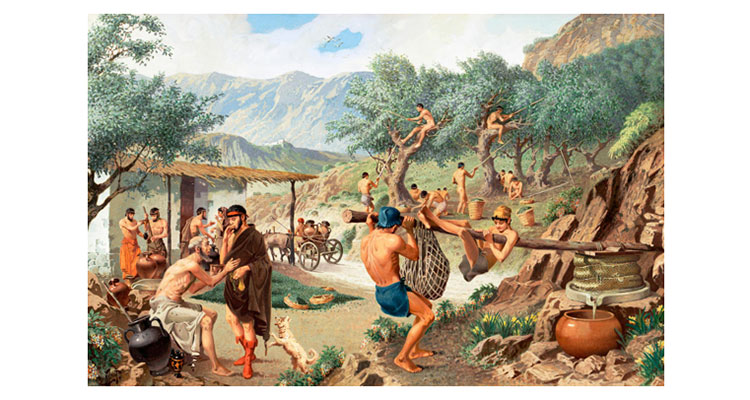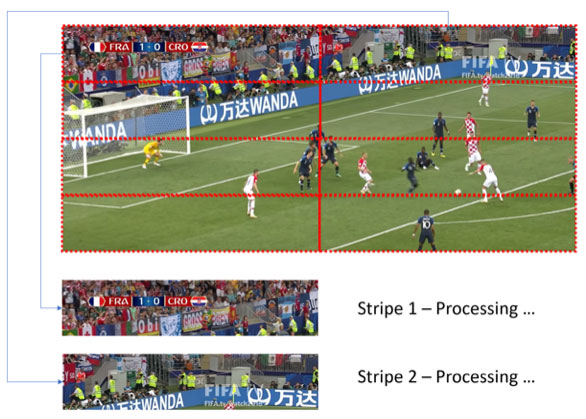(Video) Compression Is Good for You
By Tom Vanthuyne
Business Development Video Products, Silex Insight
Ever since ancient civilization, people have been compressing goods; think olive oil, wine, flour, tomato paste… it is simply the most efficient way to store and transport bulky stuff. You preserve the essentials and get rid of the redundancies.

A 1944 artist’s rendering suggests how ancient Greeks may have harvested, compressed, sampled, stored and transported olive oil. Illustration by H.M. Herget, National Geographic Creative
When it comes to video, it has not been any different ever since the early days. Clever people invented various compression schemes to reduce the required bandwidth to store and transport video signal from producer to consumer in the most economical way: Think NTSC or PAL, s-video, component video… all analog compression schemes.
The same is valid for digital data; ever since we have computers and other digital devices, we have been compressing pictures to JPEG, PNG or GIF files and large data containers are zipped and unzipped to easily store and share them with other people.
And of course, in the digital video domain it is no different: For the producer to get his content to the consumer in the highest quality within the available bandwidth, various digital compression schemes have been developed: MP4, H.264, H.265, JPEG2000, VC-2… all different toolboxes to get the best result for a certain application.
Recently, in both commercial and residential audiovisual installations, it has become obvious that IP networks are the most standard and future proof way of transporting the signals, but this might be taxing the new or existing IT infrastructures. Compressing the AV signals seems logical, but one must be very careful in the implementation: It is a delicate balance to obtain an effective compression (1), with an acceptable delay (2), and without any visible difference between the source and the display (3).
- Effective compression is of course defined by what is acceptable to the customer: If there is a 10-gigabit infrastructure available, one could say that compressing whatever video signal to 10-gigabit is sufficient. But you could also argue that given a 10-gigabit infrastructure and I can compress my video signal to 1-gigabbit, I can send 10 video signals over that same infrastructure — makes sense? The available bandwidth will always be a scarce resource whatever the current technology, and we will always take care to get the maximum out of it.Very high compression ratios can be obtained with “inter-frame” compression algorithms such as MPEG2, H.264… By nature, these compression schemes need to buffer multiple frames to be effective and, in this way, they can obtain compression rates of multiples of 100 to one, but at a cost of a long delay that can run up to hundreds of milliseconds.

Example of a live video stream: Inter-Frame Compression can take advantage of the minimal differences between frames to obtain very high compression but must buffer multiple images to be effective.
- In most applications, a delay of 30 milliseconds is considered unnoticeable to the human eye. Important to consider that the delay between an event (e.g., a live action in front of the camera, a keyboard stroke or mouse click) and the perception by the human eye in front of a display can be a long chain; delays can take place in the camera, at the various parts of the transmission chain (encoders, decoders, convertors) and at the display side. It is important to know what the total delay of the whole transmission chain will be, from “glass to glass.”

Video stream of a live event from “glass to glass” can be a long chain introducing latency (delay) between the live event and the actual visualization on a screen.
- Finally, there is the parameter of no visible difference between source and display, or what is called “visually lossless” compression. This is a very subjective matter as it depends heavily on the application and the video content that is being transmitted. If you only want to look at a variety of well-selected test patterns from morning to evening, you might be very critical to any form of compression that is being executed. Most humans however look at real life UHD video, detailed data content, PC graphics and animation… These are the types of images you should be looking at to judge the term “no visible difference.”
So-called “intra-frame” compression algorithms such as JPEG2000 or VC.2 have proven to be very effective in compressing the video stream without introducing any important delay or latency.

Intra-frame compression algorithms such as JPEG2000 or VC-2 can take part of a single image (stripes) one at a time enabling a very effective compression with a minimal latency.
Case in question: Hollywood! With the recent Digital Cinema Initiatives (DCI), film producers have been capable of creating the most beautiful content in pristine 4K resolution. But how can you deliver this fantastic content to the consumer in the most economical way? The answer they came up with is compression. DCI opted for the JPEG2000 standard to be able to show their movies in the most beautiful manner without any visible difference with the uncompressed original and keeping storage and distribution costs to the absolute minimum.
As a conclusion, one could say that distributing video-over-IP uncompressed might guarantee that there is absolutely no loss in video quality, but for most applications, smart and diligent compression makes a lot of sense as there is no visible loss in image quality, no visible delays and you save loads of bandwidth on your precious IT network. As a U.S. president once said, “It’s the economy, stupid!”
Reprinted with permission from Tom Vanthuyne and Silex Insight
About Silex Insight
Silex Insight is a world leader in security and video technology for embedded electronics. We offer solutions ranging from IP for ASIC and FPGA up to manufacturing of OEM hardware boards. Our specialized consultancy services enable us to offer tailored solutions and involved support to our customers. The company has been active in video compression since more than 15 years and received an Emmy Award for its JPEG2000 developments.
For more information, visit us here, follow us on Twitter, LinkedIn, YouTube.





